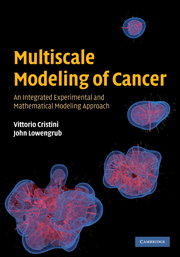Book contents
- Frontmatter
- Contents
- List of contributors
- Preface
- Acknowledgements
- Notation
- Part I Theory
- 1 Introduction
- 2 Biological background
- 3 Continuum tumor modeling: single phase
- 4 Analysis and calibration of single-phase continuum tumor models
- 5 Continuum tumor modeling: multiphase
- 6 Discrete cell modeling
- 7 Hybrid continuum–discrete tumor models
- 8 Numerical schemes
- Part II Applications
- References
- Index
8 - Numerical schemes
from Part I - Theory
Published online by Cambridge University Press: 05 October 2010
- Frontmatter
- Contents
- List of contributors
- Preface
- Acknowledgements
- Notation
- Part I Theory
- 1 Introduction
- 2 Biological background
- 3 Continuum tumor modeling: single phase
- 4 Analysis and calibration of single-phase continuum tumor models
- 5 Continuum tumor modeling: multiphase
- 6 Discrete cell modeling
- 7 Hybrid continuum–discrete tumor models
- 8 Numerical schemes
- Part II Applications
- References
- Index
Summary
In this chapter, we provide readers with a numerical framework for solving the multiphase mixture model described in Chapter 5. It is highly challenging to develop an accurate and efficient numerical method to solve such a model, which consists of high-order (fourth-order) nonlinear equations and is characterized by the interaction of small-scale features (e.g. diffuse tumor–host boundaries) with larger-scale features (e.g. the tumor morphology). Here we describe a finite-difference nonlinear multigrid method that can be used to solve the system accurately and efficiently.
The primary component of the model is a Cahn–Hilliard-type equation for the total tumor volume fraction; this is a fourth-order nonlinear advection–diffusion equation. The solutions are characterized by nearly constant states, with complex morphologies, separated by evolving narrow transition layers that describe the diffuse interfaces between the tumor and host tissues. “Slaved” to the Cahn–Hilliard (CH) equation are the equations for the remaining tumor-cell volume fractions, the cell-substrate concentrations (e.g., the oxygen and nutrient levels), and the mechanical pressure that determines cell velocity. The coupling of phenomena across widely varying length scales is a hallmark of multiphase problems. The use of a uniform mesh in such cases leads to either infeasibly large computational problems or significant limitations on the scales of problems that can be simulated. We overcome this difficulty by adopting multigrid methods with adaptive spatial refinement that uses block-structured Cartesian meshes. This balances the needs of localized fine spatial resolution and computational efficiency.
- Type
- Chapter
- Information
- Multiscale Modeling of CancerAn Integrated Experimental and Mathematical Modeling Approach, pp. 153 - 182Publisher: Cambridge University PressPrint publication year: 2010

